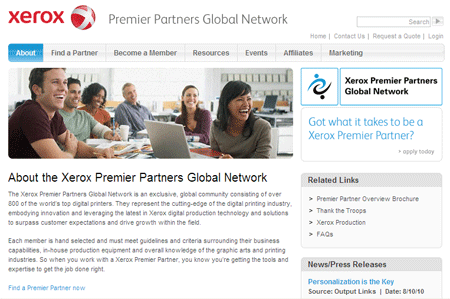The world of online marketing can be a scary place. You undoubtedly have high aspirations. You want to climb up the Google search rankings, enhance your company’s visibility, better communicate with customers, and, of course, grow your bottom-line.
If you’re at all familiar with SEO, then you know this is no simple task.
SEO-jargon is confusing, ‘best practices’ change quickly, and it seems that just when you have it all figured out…the rules change and you’re left to start afresh.
On July 10th, Xerox collaborated with Katherine Tattersfield and PrintFirm to host #InkSEO…a Twitter Chat aimed at discussing prominent inbound marketing topics with the print community.
In just one hour we covered many subjects, including terminology, on-site best practices, Google Authorship and content marketing. Here is a quick recap, complete with helpful resources, and, of course, answers to your burning questions!

Editor’s Note: Here are some helpful resources you may want to check out…we shared these during the chat:
- 50 Essential SEO Terms Financial Marketers Should Know
- Post-Hummingbird Search: An (Almost) A-Z Glossary of Winning at SEO via Hubspot
Without further ado, lets get to the questions! Drum roll please…..

Great question, John!
During our #InkSEO chat, we used a ‘cake analogy’ to describe how your web presence can be broken into multiple layers… but a ‘spider web’ analogy works well, too!
How can you ensure your website has the stickiest ‘web’ possible? Like any good response, there isn’t just one right answer. According to Google, there are about 200 ranking signals that determine how a result is displayed organically.
There are page-level factors, site-level factors, social signals, brand signals…it gets complicated rather quickly. If you’re really curious, HubSpot recently hosted an infographic clustering and depicting 200 factors that are believed to make up Google’s ranking algorithm.
If you’re interested in the synopsis, essentially there are some very real things you can be doing, today.
5 Do’s
- Identify the keywords you’d like to appear for and ensure your website and pages include these keywords. On any given page in your website, the relevant keyword should be included in the title tag (preferably in the first few words), description tag, page URL, and should be used 2 or 3 times on the page. Don’t go overboard. This should be done naturally, as overusing a keyword will surely have a negative impact.
- Use anchor text to include high-quality outbound links, such as .edu and .gov sites…although not too many! A good rule of thumb is to insert one link for every 100 or so words. (In case you’re wondering, anchor text are links that are embedded within a few descriptive keywords, helping the user understand what they can expect to see when they click the link).
- Look at your website through the eyes of the site visitor. Ensure the layout is clean and intuitive, the page loads fast, and any internal or external links add value to your reader.
- Blog, blog, blog! Every time you publish a new blog post, you’re creating another fresh page for search engines to index and customers to find you. Remember to keep the above points in mind to get the most out of your blogs.
- Leverage social media! Pages with lots of social shares send positive signals to search engines, increase your brand visibility, and tend to attract good inbound links naturally (on their own).
5 Don’ts
- Don’t skimp on the content. Pages thin on content (i.e. less than 300 words on the page) are considered low quality in Google’s eyes. It’s important to achieve quality, quantity and recency to keep the crawlers coming back!
- Don’t underestimate the power of multimedia on your site and webpages. Videos and images engage readers and enhance your storytelling.
- Don’t forget to optimize all images! Since search engines read text, they can’t interpret images unless you give them text to latch onto. This can be done by including an appropriate file name, descriptive ‘alt text’, title, description and caption.
- Don’t leave broken links! These not only frustrate users, but they may also signal to search engines that your site is neglected.
- Don’t use excessively long URL’s and permalinks, as these may hurt your search visibility. Instead, strive to optimize the length and structure of your URL’s by including your main keyword in the URL. Make sure your URLs are crawlable, meaning your descriptive words are separated by dashes (otherwise known as ‘clean URLs’). Number strings and other special characters confuse search engines and inhibit social sharing.
Helpful resources you’ll want to be sure to check out:
- An Exhaustive List of Google’s Ranking Factors (Infographic) via HubSpot
- SEO for Printers via Dreaming in CMYK
- On-Page SEO: Anatomy of a Perfectly Optimized Page via BackLinko
- On-Page Factors via Moz
- An Open Letter to the Next SEO Generation via Search Engine Land

Very good question, Christine! While having a social feed on your website won’t necessarily help from an SEO standpoint (Google crawlers don’t frequent sidebars and footers), there are other ancillary benefits you’ll receive.
A social feed that shares good content can help your site efforts. In all likelihood, your feed will be filled with not only great content from other’s sites…but also your own. This is a great way to entice site visitors to check out other pages on your website or articles you’ve written.
This concept also highlights why being active on social media is so critical! Other sites are also using social feeds, and if you are creating good content, then there’s a fair chance others are sharing your posts or linking to your webpages. This, in turn, drives traffic back to your site! How much, you ask? Well, if you’re using Google Analytics or tracking your site through another analytic platform, it should be fairly easy to identify the amount of referral traffic you’re getting and where it’s coming from.
As we mentioned above, sites whose content garners social shares and referral traffic may get a boost from Google’s ranking algorithm.

Great thought process, Matthew! As you know, achieving SEO success is not always straight-forward and can be a bit of an inexact science. Content and social media surely play a part, as does HTML structure, site architecture, links, history, reputation, paid activity, and more.
Remember, for each element which impacts SEO, there are many factors. Content is a critical component, but it’s much more than just making sure to update your blog or website regularly. It’s about the quality of content you provide, the types of words and keywords used, the freshness of the content, the inclusion of helpful links, the use of tags, the language used, the exclusion of too many ads or stuffing of keywords, etc.
Point being – it’s important to look at the bigger SEO picture to familiarize yourself on areas that may fall outside your strengths, but there’s only so much you can control. For the areas you already feel you are doing well, try not to get too complacent. Always be open to opportunities for improvement and don’t be afraid to experiment and see how variations in content strategy impact your organic search traffic.
How can you impact your company’s SEO?
No matter how big or small your company may be or what position you hold…you can play a role in directly impacting your company’s SEO.
How?
We’ve discussed how one of the components of SEO is content and the words used on your webpages. Everyone inside your company brings unique experiences and valuable insights to the table. Sales representatives have customer stories to tell, press operators are knowledgeable on how to prep files for print, and customer service representatives hear first-hand the common questions asked by customers every day.
What if all this knowledge was gathered and used to understand the language spoken by your customers? And what if that language was incorporated into your website copy? Better yet, what if each question your customer service department commonly received was turned into its own unique blog post? If customers are calling and emailing these questions, chances are they’ve tried doing their own research online and came up empty handed. But what if your research, analysis and collaboration could help drive them back to your website? Imagine the impact that could have not only on your web presence…but also your business?!
This is just the tip of the iceberg. The overarching message is simple: SEO is a highly complicated subject, but it’s worth understanding the basics because it can impact your business, and, contrary to popular belief, you can really make a difference!





This follow up was well worth the wait. You’re 100% right, Bill—everyone in an organization can impact SEO because inbound marketing is holistic by nature.
Thank you, Katherine – and it was an absolute pleasure hosting this informative session with you! There’s no doubt that SEO is confusing, but as empowered marketers creating content on a daily basis – it’s important, if not critical, to sharpen and harness these skills. You don’t have to be an expert, but there are some very simple things that all content marketers can be doing that can impact how and where they appear organically.
Thank you Katherine For this article
here an article from me talk about The On-Page SEO Factors you should pay attention to in 2016 http://ebe13.com/on-page-seo-factors/
Thanks Again For sharing this great Informations